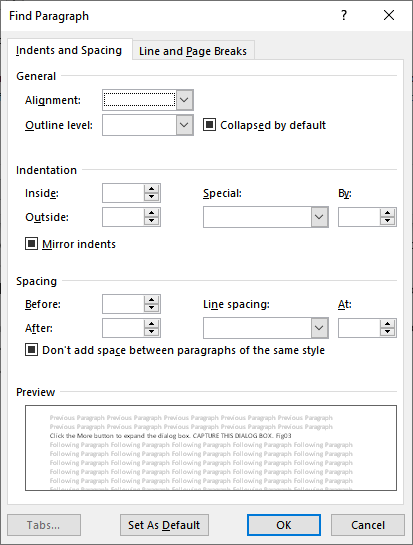Written by Allen Wyatt (last updated June 7, 2025)
This tip applies to Word 2007, 2010, 2013, 2016, 2019, 2021, 2024, and Word in Microsoft 365
Howard has a document where some paragraphs have an indented first line. He would like to find all of the indents and replace the indents with tabs.
There are several ways that this can be done, though it is unclear why it should be done. Tab characters, as the first character of a paragraph, aren't necessary to achieve an indent for a paragraph. It is much more common (and much more flexible) to use paragraph styles to control the indents necessary, first line or not, for the paragraphs in your document.
Even so, if you want to make the replacements, one way you can do so is to use Find and Replace. With the document open, follow these steps:

Figure 1. The Find Paragraph dialog box.
This process will change only those paragraphs that had their first lines indented. If you want to change all paragraphs to have a tab at the beginning, then you can do so in this manner:
This process adds a tab character in front of every paragraph with a few exceptions. First, it won't add one to the first paragraph in the document. Second, it doesn't affect any "fake paragraphs" created with line breaks. Third, it won't affect most text in tables or text boxes. Finally, it may not give exactly the result you want on paragraphs formatted as numbered or bulleted lists.
If you want to routinely make these types of changes, then a macro can be very helpful. Here's an example of one you could use:
Sub ChangeFLIndents()
Dim p As Paragraph
For Each p In ActiveDocument.Paragraphs
If p.FirstLineIndent > 0 Then
p.FirstLineIndent = 0
p.Range.InsertBefore vbTab
End If
Next p
End Sub
The macro looks at every paragraph and affects only those that have a first-line indent. In other words, it doesn't affect all paragraphs. In this regard it is very similar to the first Find and Replace technique described in tis tip.
Note:
WordTips is your source for cost-effective Microsoft Word training. (Microsoft Word is the most popular word processing software in the world.) This tip (10534) applies to Microsoft Word 2007, 2010, 2013, 2016, 2019, 2021, 2024, and Word in Microsoft 365.

Learning Made Easy! Quickly teach yourself how to format, publish, and share your content using Word 2021 or Microsoft 365. With Step by Step, you set the pace, building and practicing the skills you need, just when you need them! Check out Microsoft Word Step by Step today!
Word includes two different search engines. Which search engine you choose to use will dictate what Word shows as ...
Discover MoreIf you need to find words that mix uppercase and lowercase characters together, you will appreciate this tip. Here I show ...
Discover MoreWant a quick, easy way to "search again" for the next occurrence of what you need? Use the technique in this tip and ...
Discover MoreFREE SERVICE: Get tips like this every week in WordTips, a free productivity newsletter. Enter your address and click "Subscribe."
There are currently no comments for this tip. (Be the first to leave your comment—just use the simple form above!)
Got a version of Word that uses the ribbon interface (Word 2007 or later)? This site is for you! If you use an earlier version of Word, visit our WordTips site focusing on the menu interface.
Visit the WordTips channel on YouTube
FREE SERVICE: Get tips like this every week in WordTips, a free productivity newsletter. Enter your address and click "Subscribe."
Copyright © 2025 Sharon Parq Associates, Inc.
Comments